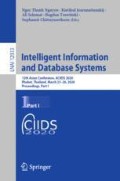Abstract
This paper presents the problem of calculating the value of the scoring function for weak classifiers operating in the sequential structure. An example of such a structure is Gentle AdaBoost algorithm whose modification we propose in this work. In the proposed approach the distance of the object from the decision boundary is scaled in decision regions defined by the weak classifier at first and later transformed by the log-normal function. The described algorithm was tested on sixth public available data sets and compared with Gentle AdaBoost algorithm.
Access this chapter
Tax calculation will be finalised at checkout
Purchases are for personal use only
References
Platt, J., et al.: Probabilistic outputs for support vector machines and comparisons to regularized likelihood methods. Adv. Large Margin Classif. 10(3), 61–74 (1999)
Kuncheva, L.I.: Combining Pattern Classifiers: Methods and Algorithms, 1st edn. Wiley-Interscience, Hoboken (2004)
Lam, L., Suen, S.: Application of majority voting to pattern recognition: an analysis of its behavior and performance. IEEE Trans. Syst. Man Cybern.-Part A: Syst. Hum. 27(5), 553–568 (1997)
Ruta, D., Gabrys, B.: Classifier selection for majority voting. Inf. Fusion 6(1), 63–81 (2005)
Przybyła-Kasperek, M., Wakulicz-Deja, A.: Dispersed decision-making system with fusion methods from the rank level and the measurement level–a comparative study. Inf. Syst. 69, 124–154 (2017)
Fumera, G., Roli, F.: A theoretical and experimental analysis of linear combiners for multiple classifier systems. IEEE Trans. Pattern Anal. Mach. Intell. 6, 942–956 (2005)
Kittler, J., Alkoot, F.M.: Sum versus vote fusion in multiple classifier systems. IEEE Trans. Pattern Anal. Mach. Intell. 25(1), 110–115 (2003)
Kuncheva, L.I., Bezdek, J.C., Duin, R.P.: Decision templates for multiple classifier fusion: an experimental comparison. Pattern Recogn. 34(2), 299–314 (2001)
Woźniak, M., Graña, M., Corchado, E.: A survey of multiple classifier systems as hybrid systems. Inf. Fusion 16, 3–17 (2014)
Xu, L., Krzyzak, A., Suen, C.Y.: Methods of combining multiple classifiers and their applications to handwriting recognition. IEEE Trans. Syst. Man Cybern. 22(3), 418–435 (1992)
Freund, Y., Schapire, R.E.: A decision-theoretic generalization of on-line learning and an application to boosting. J. Comput. Syst. Sci. 55(1), 119–139 (1997)
Burduk, R.: The AdaBoost algorithm with the imprecision determine the weights of the observations. In: Nguyen, N.T., Attachoo, B., Trawiński, B., Somboonviwat, K. (eds.) ACIIDS 2014. LNCS (LNAI), vol. 8398, pp. 110–116. Springer, Cham (2014). https://doi.org/10.1007/978-3-319-05458-2_12
Shen, C., Li, H.: On the dual formulation of boosting algorithms. IEEE Trans. Pattern Anal. Mach. Intell. 32(12), 2216–2231 (2010)
Oza, N.C.: Boosting with averaged weight vectors. In: Windeatt, T., Roli, F. (eds.) MCS 2003. LNCS, vol. 2709, pp. 15–24. Springer, Heidelberg (2003). https://doi.org/10.1007/3-540-44938-8_2
Freund, Y., Schapire, R.E., et al.: Experiments with a new boosting algorithm. In: ICML, vol. 96, pp. 148–156. Citeseer (1996)
Wozniak, M.: Proposition of boosting algorithm for probabilistic decision support system. In: Bubak, M., van Albada, G.D., Sloot, P.M.A., Dongarra, J. (eds.) ICCS 2004. LNCS, vol. 3036, pp. 675–678. Springer, Heidelberg (2004). https://doi.org/10.1007/978-3-540-24685-5_117
Frejlichowski, D., Gościewska, K., Forczmański, P., Nowosielski, A., Hofman, R.: Applying image features and AdaBoost classification for vehicle detection in the ‘SM4Public’ system. In: Choraś, R.S. (ed.) Image Processing and Communications Challenges 7. AISC, vol. 389, pp. 81–88. Springer, Cham (2016). https://doi.org/10.1007/978-3-319-23814-2_10
Graczyk, M., Lasota, T., Trawiński, B., Trawiński, K.: Comparison of bagging, boosting and stacking ensembles applied to real estate appraisal. In: Nguyen, N.T., Le, M.T., Świątek, J. (eds.) ACIIDS 2010. LNCS (LNAI), vol. 5991, pp. 340–350. Springer, Heidelberg (2010). https://doi.org/10.1007/978-3-642-12101-2_35
Kozik, R., Choraś, M.: The HTTP content segmentation method combined with AdaBoost classifier for web-layer anomaly detection system. In: Graña, M., López-Guede, J.M., Etxaniz, O., Herrero, Á., Quintián, H., Corchado, E. (eds.) SOCO/CISIS/ICEUTE -2016. AISC, vol. 527, pp. 555–563. Springer, Cham (2017). https://doi.org/10.1007/978-3-319-47364-2_54
Wu, S., Nagahashi, H.: Analysis of generalization ability for different AdaBoost variants based on classification and regression trees. J. Electrical Comput. Eng. 2015, 8 (2015)
Burduk, R., Bozejko, W.: Gentle AdaBoost algorithm with score function dependent on the distance to decision boundary. In: Saeed, K., Chaki, R., Janev, V. (eds.) CISIM 2019. LNCS, vol. 11703, pp. 303–310. Springer, Cham (2019). https://doi.org/10.1007/978-3-030-28957-7_25
Dmitrienko, A., Chuang-Stein, C., D’Agostino, R.B.: Pharmaceutical statisticsusing SAS: a practical guide. SAS Institute (2007)
Guyon, I., Elisseeff, A.: An introduction to variable and feature selection. J. Mach. Learn. Res. 3, 1157–1182 (2003)
Rejer, I.: Genetic algorithms for feature selection for brain computer interface. Int. J. Pattern Recogn. Artif. Intell. 29(5), 1559008 (2015)
Szenkovits, A., Meszlényi, R., Buza, K., Gaskó, N., Lung, R.I., Suciu, M.: Feature selection with a genetic algorithm for classification of brain imaging data. In: Stańczyk, U., Zielosko, B., Jain, L.C. (eds.) Advances in Feature Selection for Data and Pattern Recognition. ISRL, vol. 138, pp. 185–202. Springer, Cham (2018). https://doi.org/10.1007/978-3-319-67588-6_10
Giełczyk, A., Wawrzyniak, R., Choraś, M.: Evaluation of the existing tools for fake news detection. In: Saeed, K., Chaki, R., Janev, V. (eds.) CISIM 2019. LNCS, vol. 11703, pp. 144–151. Springer, Cham (2019). https://doi.org/10.1007/978-3-030-28957-7_13
Topolski, M.: Algorithm of multidimensional analysis of main features of PCA with blurry observation of facility features detection of carcinoma cells multiple myeloma. In: Burduk, R., Kurzynski, M., Wozniak, M. (eds.) CORES 2019. AISC, vol. 977, pp. 286–294. Springer, Cham (2020). https://doi.org/10.1007/978-3-030-19738-4_29
Acknowledgment
This work was supported by the National Science Centre, Poland under the grant no. 2017/25/B/ST6/01750.
Author information
Authors and Affiliations
Corresponding authors
Editor information
Editors and Affiliations
Rights and permissions
Copyright information
© 2020 Springer Nature Switzerland AG
About this paper
Cite this paper
Burduk, R., Bożejko, W., Zacher, S. (2020). Novel Approach to Gentle AdaBoost Algorithm with Linear Weak Classifiers. In: Nguyen, N., Jearanaitanakij, K., Selamat, A., Trawiński, B., Chittayasothorn, S. (eds) Intelligent Information and Database Systems. ACIIDS 2020. Lecture Notes in Computer Science(), vol 12033. Springer, Cham. https://doi.org/10.1007/978-3-030-41964-6_52
Download citation
DOI: https://doi.org/10.1007/978-3-030-41964-6_52
Published:
Publisher Name: Springer, Cham
Print ISBN: 978-3-030-41963-9
Online ISBN: 978-3-030-41964-6
eBook Packages: Computer ScienceComputer Science (R0)

